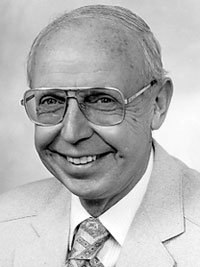Willis Howard Ware
Born August 31, 1920, Atlantic City, N.J.; computer engineer who assisted John von Neumann to develop the IAS machine, and who took charge of the subsequent development of the JOHNNIAC at Rand Corporation. He was the first president of AFIPS.

Education: BS, electrical engineering, Moore School of Electrical Engineering, University of Pennsylvania; SM, electrical engineering, MIT, 1942; PhD, electrical engineering, Princeton University, 1951.
Professional Experience: research engineer, Hazeltine Electronics Corporation, Little Neck, N.Y., 1942-1946; Institute for Advanced Study, Princeton University, 1946-1951; North American Aviation Corp., 1951-1952; Rand Corp., 1952-present; adjunct professor, University of California at Los Angeles, 1955-1968.
Honors and Awards: Atwater Kent Prize, Moore School of Electrical Engineering, University of Pennsylvania, 1941; National Fellowship, Tau Beta Pi, 1941-1942; Achievement Award, Los Angeles Chapter, IRE, 1957; fellow, IRE, 1962; Distinguished Service Award, AMPS, 1963 and 1986; Computer Sciences Man of the Year, Data Processing Management Association, 1975; Exceptional Civil Service Medal, US Air Force, 1979; Centennial Award, IEEE, 1984; member, National Academy of Engineering, 1985; National Computer System Security Award, 1989; Computer Pioneer Award, IEEE Computer Society, 1993; fellow, ACM, 1994; IFIP Kristian Beckman Award, 1999; Electronic Privacy Information Center Lifetime Achievement Award, 2012; Cyber Security Hall of Fame, 2013.
After working on classified electronics systems During World War II, Willis worked at Princeton for John von Neumann, building the IAS computer. He then worked at North American Aviation in Los Angeles before joining the Rand corporation, where he worked for over 40 years.
He taught one of the first computing courses, beginning in 1952, at the UCLA Extension Division.
Willis was 1958-59 chair of one of the two predecessor organizations that merged into being the IEEE Computer Society.
Willis was chair of the 1970s United States Department of Health, Education, and Welfare Advisory Committee on Automated Personal Data Systems, and vice chair of the President's Privacy Protection Study Commission.
Comments
The following comments came in the days after Willis Ware's death, when additionally major newspapers published his obituary.
Dave Walden writes: "I worked closely with Willis for 8 years a few decades ago when we were both members of the Air Force Scientific Advisory Board. We kept in touch off and on in the years since. Willis was a wonderful technologist and organizer of technology people; he also was a wonderful man."
Here is an additional perspective about Willis Ware's contributions, from a SIGCIS mailing list contribution by Robert L. Patrick, who worked with Ware at Rand:
After the Johnniac had a memory change (to core planes) Willis froze the design and worked at Rand on other subjects. The Johnniac then was used as a production machine for a number of years and finally got new software which turned it into a small online service: JOHNNIAC Open Shop System (JOSS). It supported several systems over the years, including Newell, Shaw and Simon's Information Processing Language (IPL).
Meanwhile, Willis got involved in starting the profession. He and Keith Uncapher organized AFIPS and both sequentially chaired it for a while. It sponsored big conferences to make money to use for good purposes. One of their projects was to find volunteers to write "best practices" manuals to guide the developing field. They sponsored one on security, the author they chose fouled out, and I took over and published the first manual on computer security in 1962 or so.
Willis had a quiet non-threatening personality. He worked well with high military officials who wore their egos on their sleeves. I worked on his team in trying to fix the Air Force logistics system development, which was as big as IBM's OS/360 but without as much talent. It failed and the USAF kept reviving it under another name until Congress made it a line item in the USAF Budget so they could kill it.
He helped me push through a formal Rand Recommendation to the AF Chief of Staff to establish a series of skill codes within the officer corps so officers with computer skills could be identified and assigned correctly. I could not have done it without him.
He and I had several intelligence assignments separately and together. We both held TS clearances.
He pushed through the Department of Defense Computer Institute (DODCI) which is still going under another name. We both were initial lecturers. The first class of students were all Generals and Admirals.
BIBLIOGRAPHY
Biographical
N. Stern, "An Interview with Willis H. Ware," Charles Babbage Institute, Univ. of Minnesota, CBU accession number OH37, 19 Jan. 1981.
J.R. Yost, "An Interview with Willis Ware," Charles Babbage Institute, Univ. of Minnesota, CBU accession number OH356, 11 Aug. 2003.
David Walden, "Willis Ware," IEEE Annals of the History of Computing, July-September 2011, pp 67-73.
Significant Publications
W.H. Ware, "The Logical Principles of a New Kind of Binary Counter," Proceedings of the IRE, vol. 14, no. 10, Oct. 1953, pp. 1429–1437.
W.H. Ware, Digital Computer Technology and Design, vols. I and II, John Wiley & Sons, 1963.
Willis Ware, JOHNNIAC Eulogy, Report P-3313, RAND Corporation, March 1966.
Security Controls for Computer Systems, tech. report R-609-PR, RAND, Defense Science Board Task Force on Computer Security, 1972. R-609- 1-PR was reissued Oct. 1979. This widely circulated report was informally known as "the Ware report."
W.H. Ware, Records, Computers and the Rights of Citizens, DHEW publication (OS)73-94, stock no. 1700-00166, US Government Printing Office, 1973.
W.H. Ware, RAND and the Information Evolution: A History in Essays and Vignettes, RAND Corporation, 2008.
UPDATES
Portrait changed (MRW, 2013)
Portrait changed (DCW, 2013)
Willis Ware died on November 22, 2013. Expanded the biography and bibliography with information from Dave Walden and others. (THVV, 2013)
New content Copyright © 2013-2023 by the IEEE Computer Society and the Institute of Electrical and Electronics Engineers Inc.
All rights reserved. This material may not be reproduced or redistributed without the express written permission of the copyright holder.
